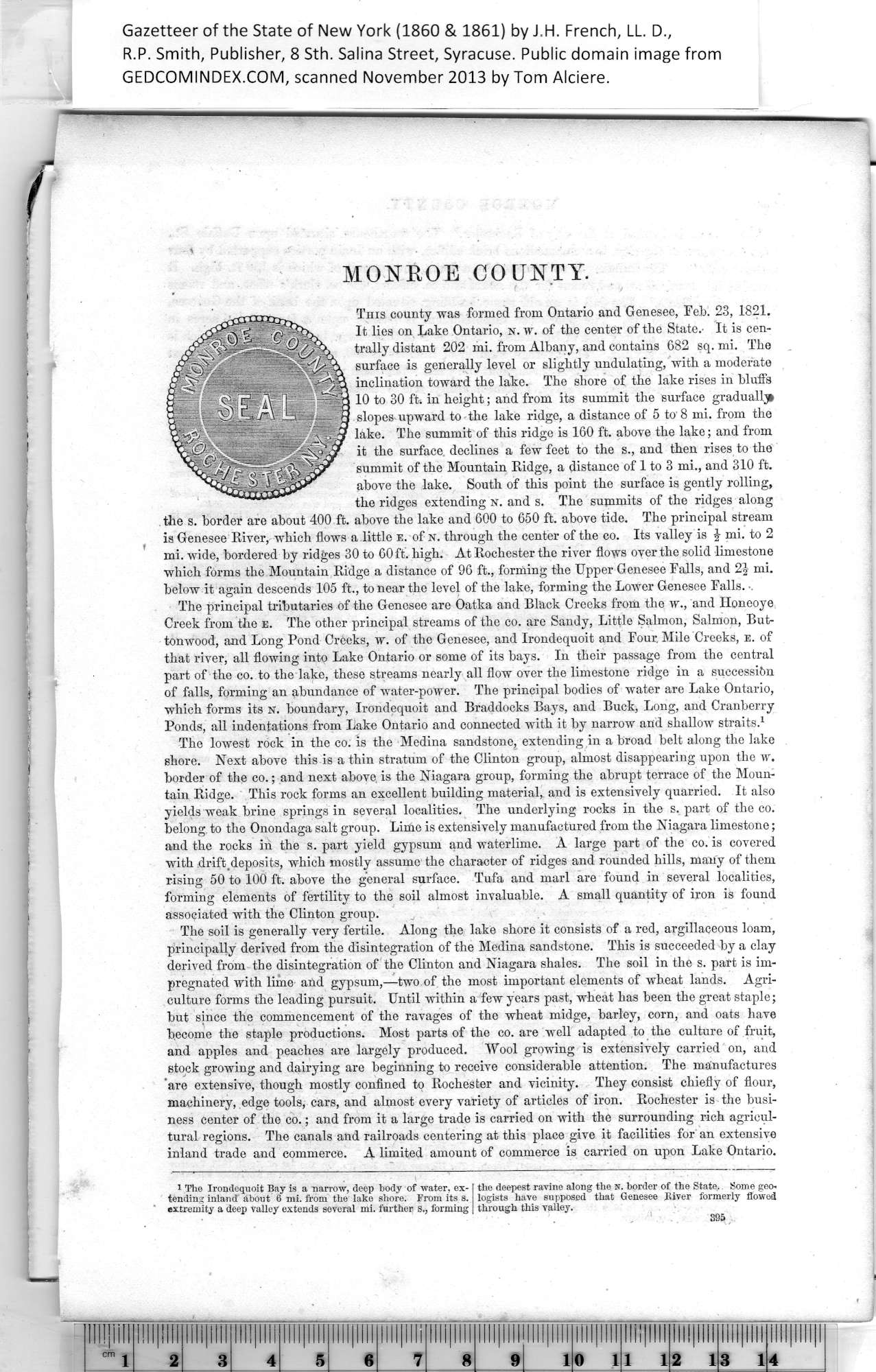|
MONKOE COUNTY.
This county was formed from Ontario and Genesee, Feb. 23, 1821.
It lies on Lake Ontario, n. w. of the center of the State.- It is cen¬
trally distant 202 mi. from Albany, and contains 682 sq. mi. The
surface is generally level or slightly undulating, with a moderate
inclination toward the lake. The shore of the lake rises in bluffs
10 to 30 ft. in height; and from its summit the surface gradually
slopes upward to the lake ridge, a distance of 5 to 8 mi. from the
lake. The summit of this ridge is 160 ft. above the lake; and from
it the surface, declines a few feet to the s., and then rises to the
summit of the Mountain Ridge, a distance of 1 to 3 mi., and 310 ft.
above the lake. South of this point the surface is gently rolling,
the ridges extending n. and s. The summits of the ridges along
above the lake and 600 to 650 ft. above tide. The principal stream
is Genesee River, which flows a little e. of n. through the center of the co. Its valley is J mi. to 2
the s. border are about 400 ft.
mi. wide, bordered by ridges 30 to 60 ft. high. At Rochester the river flows over the solid limestone
which forms the Mountain Ridge a distance of 96 ft., forming the Upper Genesee Falls, and 2J mi.
below it again descends 105 ft., to near the level of the lake, forming the Lower Genesee Falls.
The principal tributaries of the Genesee are Oatka and Black Creeks from the w., and Honeoye
Creek from the e. The other principal streams of the co. are Sandy, Little Salmon, Salmon, But¬
tonwood, and Long Pond Creeks, w. of the Genesee, and Irondequoit and Four. Mile Creeks, e. of
that river, all flowing into Lake Ontario or some of its bays. In their passage from the central
part of the co. to the lake, these streams nearly all flow over the limestone ridge in a succession
of falls, forming an abundance of water-power. The principal bodies of water are Lake Ontario,
which forms its n. boundary, Irondequoit and Braddocks Bays, and Buck, Long, and Cranberry
Ponds, all indentations from Lake Ontario and connected with it by narrow and shallow straits.1
The lowest rock in the co. is the Medina sandstone, extending in a broad belt along the lake
shore. Next above this is a thin stratum of the Clinton group, almost disappearing upon the w.
border of the co.; and next above is the Niagara group, forming the abrupt terrace of the Moun¬
tain Ridge. This rock forms an excellent building material, and is extensively quarried. It also
yields weak brine springs in several localities. The underlying rocks in the s. part of the co.
belong to the Onondaga salt group. Lime is extensively manufactured from the Niagara limestone;
and the rocks in the s. part yield gypsum and waterlime. A large part of the co. is covered
with drift.deposits, which mostly assume the character of ridges and rounded hills, many of them
rising 50 to 100 ft. above the general surface. Tufa and marl are found in several localities,
forming elements of fertility to the soil almost invaluable. A small quantity of iron is found
associated with the Clinton group.
The soil is generally very fertile. Along the lake shore it consists of a red, argillaceous loam,
principally derived from the disintegration of the Medina sandstone. This is succeeded by a clay
derived from the disintegration of the Clinton and Niagara shales. The soil in the s. part is im¬
pregnated with lime and gypsum,—two of the most important elements of wheat lands. Agri¬
culture forms the leading pursuit. Until within a few years past, wheat has been the great staple;
but since the commencement of the ravages of the wheat midge, barley, corn, and oats have
become the staple productions. Most parts of the co. are well adapted to the culture of fruit,
and apples and peaches are largely produced. Wool growing is extensively carried on, and
stock growing and dairying are beginning to receive considerable attention. The manufactures
’are extensive, though mostly confined to Rochester and vicinity. They consist chiefly of flour,
machinery, edge tools, cars, and almost every variety of articles of iron. Rochester is the busi¬
ness center of the co.; and from it a large trade is carried on with the surrounding rich agricul¬
tural regions. The canals and railroads centering at this place give it facilities for an extensive
inland trade and commerce. A limited amount of commerce is carried on upon Lake Ontario.
895
1
The Irondequoit Bay is a narrow, deep body of water, ex-1 the deepest ravine along the n. border of the State. Some geo-
tending inland about 6 mi. from the lake shore. From its s. logists have supposed that Genesee liiver formerly flowed
extremity a deep valley extends several mi. further s., forming | through this valley.
|
